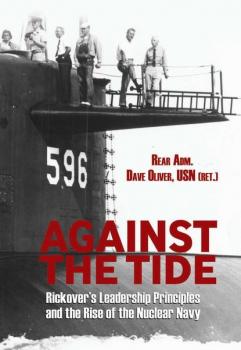ТОП просматриваемых книг сайта:
Прочая образовательная литература
Различные книги в жанре Прочая образовательная литература, доступные для чтения и скачиванияАннотация
Foreword by Colin L. Powell. In January 1944 sixteen black enlisted men gathered at the Great Lakes Naval Training Station in Illinois to begin a cram course that would turn them into the U.S. Navy's first African-American officers on active duty. The men believed they could set back the course of racial justice if they failed and banded together so all would succeed. Despite the demanding pace, all sixteen passed the course. Twelve were commissioned as ensigns and a thirteenth was made a warrant officer. Years later these pioneers came to be known as the Golden Thirteen, but at the outset they were treated more as pariahs than pioneers. Often denied the privileges and respect routinely accorded white naval officers, they were given menial assignments unworthy of their abilities and training. Yet despite this discrimination, these inspirational young men broke new ground and opened the door for generations to come.In 1986, oral historian Paul Stillwell began recording the memories of the eight surviving members of the Golden Thirteen. Later he interviewed three white officers who served with and supported the efforts of the men during World War II. This book collects the stories of those eleven men. Introduced by Colin L. Powell, they tell in dramatic fashion what it was like to be a black American
Аннотация
In the tradition of great tales of men against the sea, this story offers a compelling look at courage and commitment in the face of certain tragedy. It is a powerful blend of human drama and real-life naval operations, but unlike most books in the genre, its heroes are airmen not seamen, and most survived their ordeal. Published on the twentieth-fifth anniversary of Alfa Foxtrot 586's fatal mission as a tribute to those lost, the account was written by a naval aviator who has flown the same aircraft on the same mission from the same air base. The aircraft is a P-3 Orion on station during a sensitive mission off the Kamchatka Peninsula in the north Pacific. The time is mid-day on 26 October 1978. Andy Jampoler takes readers into the cockpit of the turboprop as a propeller malfunction turns into an engine fire, eventually forcing Jerry Grigsby to ditch his patrol plane into the empty, mountainous seas west of the Aleutian Islands. His fourteen crewmembers, strapped in their seats, expect the worst–and get it. The aircraft goes down in just ninety seconds, taking one of the three rafts with it. A second raft, terribly overcrowded, soon begins to leak.The flight crew's desperate battle to survive is told with the authority, drama, and sensitivity that only someone with the author's background could provide. He draws on interviews with survivors, searchers, and even the master of the Soviet fishing trawler that saved the living and recovered the bodies of the dead. He also draws on recordings of radio communications, messages in the files of the state and defense departments, and the patrol squadron's own investigation of the ditching. Everyone who likes survival epics and enjoys reading sea and air adventures will be entertained by this engrossing true story.
Аннотация
Rear Admiral Terry McKnight, USN (Ret.) served as Commander, Counter-Piracy Task Force-Gulf of Aden. He wrote the first draft of the Navy’s handbook on fighting piracy while serving as the initial commander of Combined Task Force 151, an international effort to deploy naval vessels from several nations in a manner designed to prevent piracy in the Gulf of Aden and farther out into the Indian Ocean. McKnight personally commanded operations that disrupted several hijackings in progress, and resulted in the capture of sixteen Somali pirates. That’s when he ran head-on into the bizarre U.S. policy of catch-and-release, and realized that there’s a lot more to fighting piracy than just catching some skinny youngsters armed with AK-47s and RPGs.After his tour in the waters off the Horn of Africa and the Arabian Peninsula, he retired from the Navy and began seriously researching the subject. As a result, he and his co-author, journalist Michael Hirsh, have put together a very readable book that serves as a comprehensive introductory course on the subject. Pirate Alley includes a behind-the-scenes look at the SEAL Team 6 takedown of the pirates who had kidnapped Captain Richard Phillips of the Maersk Alabama. It also reveals what a young Ph.D. candidate from Duke University found during three months on the ground in Somali pirate villages.Pirate Alley explores every aspect of Somali piracy, from how the pirates operate to how the actions of a relative handful of youthful criminals and their bosses have impacted the world economy. The book examines various answers to the question “How do you solve a problem like Somalia?” It explores the debate over the recently adopted practice of putting armed guards aboard merchant ships, and focuses on the best management practices that are changing the ways that ships are outfitted for travel through what’s known as the High Risk Area. Readers will learn that the consequence of protecting high quality targets such as container ships and crude oil carriers may be that pirates turn to crime on land, such as the kidnapping of foreigners.The work also focuses on the worldwide economic impact of piracy, noting that despite claims that piracy is costing as much as $13 billion a year, one of the largest commercial shipping companies argues that over-reaching national and international shipping regulations have a significantly greater negative effect on the world’s economy than does piracy.In the book’s conclusion, McKnight contends that, in the interest of justice, nations need to beef up their ability to prosecute and imprison captured pirates. And that the United States has no choice but to continue to hew to a policy that was first stated in Article 1 of the U.S. Constitution: The Congress shall have Power…to define and punish Piracies and Felonies committed on the high Seas, and Offences against the Law of Nations.
Аннотация
Admiral Hyman Rickover personally revolutionized naval warfare and altered the outcome of the Cold War. Concurrently he drove innovation into American industry – which in the decades since has proven to be a wellspring of power for American technology. As a touchstone of his success, during Rickover’s stewardship the Russians had literally dozens of reactor accidents, but Rickover’s single-minded focus on safety protected Americans as well as and our lands from nuclear contamination.Rickover did all of this initially by the force of his own personality and eventually by insisting on radical culture change. The author had the good fortune to personally know and be involved with Admiral Rickover as well as many of the most interesting players and protagonists during much of this thirty year process of wrenching cultural upheaval. The author leaves detailed biographical details of Rickover to others, instead focusing on previously unknown historical events in which he personally participated or had unique knowledge which highlight the management and leadership principles behind Rickover’s achievements and place important events (President Eisenhower choosing nuclear submarines to counter Sputnik, development of the Polaris Fleet, the relationship of Admirals Zumwalt and Rickover, the loss of USS Scorpion, the superiority of the American submarines over the Soviet fleet, etc.) in an historical perspective.Because of his life’s work, the author is uniquely qualified to apply many of Rickover’s principles to other situations. For example, Dave well understands the particular navy culture Rickover had to destroy for the author began his own career on a diesel boat. Similarly since the author spent a decade in US industry as either the Chief Executive Officer or the Chief Operating Officer, he understands how to identify situations where Rickover’s principles can be applied to industry circumstances. This is done at the end of each chapter in the book, thus providing a starting point for any who wish to use this source for case studies.
Аннотация
First published in 1994, this stirring autobiography of a fighter and test pilot takes readers full throttle through Carl's imposing list of «firsts.» Beginning with his World War II career, he gained such commendations as first Marine Corps ace, among the first Marines ever to fly a helicopter, and first Marine to land aboard an aircraft carrier. His combat duty included the momentous battles at Midway and Guadalcanal. Not one to rest on his laurels, however, he participated in photoreconnaissance operations over Red China in 1955 and flew missions in Vietnam. In peacetime he gamed fame for «pushing the envelope» as a test pilot, adding the world's altitude and peace records to his wartime feats and becoming the first U.S. military aviator to wear a full pressure suit. Such achievements also led to Carl's being the first living Marine admitted to the Naval Aviation Hall of Honor, as well as the first Marine to be named to the Navy Carrier Aviation Test Pilots Hall of Honor. This very readable memoir is as forthright and compelling as the man it chronicles.
Аннотация
This all-new 5th edition of the venerable Service Etiquette cements the guide's reputation as the definitive resource of military protocol. International protocol experts Cherlynn Conetsco and Anna Hart have totally rewritten the book, expanding its scope and intended readership from military officers and military spouses to all levels of the military, government, and business professionals. With forty-plus years of collective experience, they are recognized masters in modern etiquette and civility. Universally applicable, the new edition is a highly readable, multicultural courtesy and planning manual that provides entry-level professionals with a wealth of hands-on detail and vital skill sets. To seasoned military leaders and corporate executives, it offers useful insights in refining social and business models for a diverse selection of both domestic and international constituencies. Throughout the reference guide, Conetsco and Hart share fascinating insights, the latest official information, and modern civility advice. They introduce new material covering international guest and host etiquette, including manners at the global dinner table, public use of personal electronic devices and email manners, and essential protocol during government ceremonies, business receptions, and high-profile visits. They spotlight individual responsibilities, such as proposing toasts and navigating receiving lines, in detail. Seating plans are included for conference rooms, auditoriums, and dining tables. There are checklists and step-by-step scripts for organizing a Dining In or a Fallen Comrade observance. For fast reference, the first page of each chapter includes a box listing key points covered.
Аннотация
This collection of essays examines the lives of thirteen naval officers whose careers had lasting effects on the evolution of American naval traditions.
Аннотация
In this revealing work, Dag Henriksen discloses the origins and content of NATO's strategic and conceptual thinking on how the use of force was to succeed politically in altering the behavior of the Federal Republic of Yugoslavia (FRY). The air campaign, known as Operation Allied Force, was the first war against any sovereign nation in the history of NATO and the first major combat operation conducted for humanitarian purposes against a state committing atrocities within its own borders. This book examines the key political, diplomatic, and military processes that shaped NATO and U.S. management of the Kosovo crisis and shows how air power became the main instrument in their strategy to coerce the FRY to accede to NATO's demands.The book further shows that the military leaders set to execute the campaign had no clear strategic guidance on what the operation was to achieve and that the level of uncertainty was so high that the officers selecting the bombing targets watched NATO's military spokesman on CNN for guidance in choosing their targets. Henriksen argues that structures preceding the Kosovo crisis shaped the management to a much greater degree than events taking place in Kosovo and that the air power community's largely institutionalized focus on high-intensity conflicts, like the 1991 Gulf War, hampered them from developing strategies to fit the political complexities of crises. Because fighting and wars in the lower end of the intensity spectrum are likely to surface again, study of the Kosovo crisis offers lessons for future international conflicts in which the combination of force and diplomacy will play a very significant role.
Аннотация
The U.S. Naval Institute Chronicles series focuses on the relevance of history by exploring topics like significant battles, personalities, and service components. Tapping into the U.S. Naval Institute's robust archives, these carefully selected volumes help readers understand nuanced subjects by providing unique perspectives and some of the best contributions that have helped shape naval thinking over the many decades since the Institute’s founding in 1873.Meeting the challenges of gender integration has been a “joint” operation that has encompassed all of the armed forces. This edition of Naval Institute Chronicles tells a significant portion of the evolutionary and revolutionary transition from the days of “yeomanettes” to today’s Navy—where women command ships and wear admirals’ stars.
Аннотация
From the late 1960s through the mid-1980s, a small band of military activists waged war against corruption in the Pentagon, challenging a system they believed squandered the public’s money and trust. The book examines the movement and its proponents and describes how the system responded to the criticisms and efforts to change accepted practices and entrenched ways of thinking.The author, an air force colonel and part of the movement, worked in the pentagon for fourteen years. He presents a view of the Department of Defense that only an insider could offer. He exposes serious flaws in the military policy-making process, particularly in weapons development and procurement. The details he gives on the unrelenting push for high-tech weapons, despite their ineffectiveness and extraordinary cost-overruns, provide a strong case for the charge of ethical bankruptcy.The second half of the book deals with the author’s attempts to get frontline equipment tested under combat conditions. For the first time, readers learn the nasty details of his battle with the army over line-fire testing of the Bradley Fighting Vehicle—a battle that he eventually won, leading to the personnel carrier’s redesign and the saving of many lives.Never reluctant to name names and reveal details, James G. Burton presents a forceful case. And his revelations offer insights not found elsewhere into the motivations and actions of the people who wield power from within. Nor does he stop at the walls of the Pentagon. In his epilogue he tells what happened in the field during the final hours of the Gulf War that allowed Hussein’s elite Republican Guard to escape.Now back in print after having inspired a feature HBO film, this explosive account of insider corruption is sure to serve policy-makers for generations to come.










